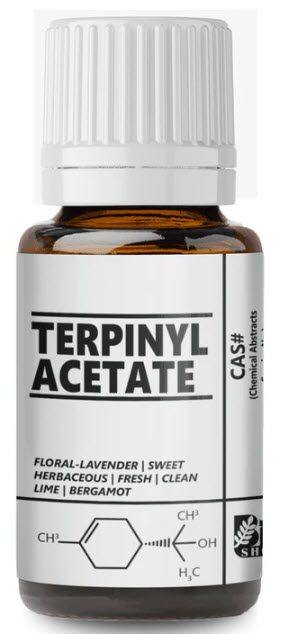Terpinyl acetate is a widely used aroma chemical in the fragrance and flavor industry. It is valued for its fresh, herbal, and slightly floral scent, which makes it a popular choice for creating natural, green, and uplifting fragrances. Below is a detailed explanation of terpinyl acetate, including its properties, uses, and significance in perfumery.

1. Chemical Structure and Properties
- Chemical Name: Terpinyl acetate
- IUPAC Name: 2-(4-Methylcyclohex-3-en-1-yl)propan-2-yl acetate
- Molecular Formula: C₁₂H₂₀O₂
- Molecular Weight: 196.29 g/mol
- Appearance: A colorless to pale yellow liquid.
- Odor: Fresh, herbal, slightly floral, and citrusy with a woody undertone.
- Solubility: Insoluble in water but soluble in alcohol and oils, making it suitable for use in perfumes and cosmetic formulations.
- Boiling Point: Approximately 220°C (428°F).
- Stability: Stable under normal conditions but can degrade under strong acids, bases, or UV light.
2. Natural Occurrence
Terpinyl acetate occurs naturally in many essential oils and plant extracts, including:
- Cardamom
- Pine
- Fir
- Eucalyptus
- Lavender
- Marjoram
However, the terpinyl acetate used in perfumery is typically synthesized in laboratories to ensure consistency, purity, and cost-effectiveness.
3. Role in Perfumery
Terpinyl acetate is a versatile fragrance ingredient with several key roles:
- Top Note: It is often used as a top note in perfumes, providing an immediate burst of freshness and herbal brightness.
- Blending Agent: It harmonizes well with other herbal, citrus, and woody notes, creating a balanced and natural scent profile.
- Herbal Enhancer: It enhances herbal and green accords, particularly in compositions featuring lavender, pine, and eucalyptus.
- Fixative: It helps stabilize and prolong the scent of a perfume by slowing down the evaporation of more volatile components.
4. Fragrance Profile
Terpinyl acetate contributes the following olfactory characteristics to a perfume:
- Fresh: Adds a bright, uplifting, and invigorating quality.
- Herbal: Enhances herbal and green accords, particularly in lavender and pine compositions.
- Floral: Imparts a subtle, sweet, and slightly floral undertone.
- Citrusy: Provides a light, lemony, and slightly tangy freshness.
- Woody: Adds a soft, woody base note, grounding the fragrance.
5. Common Uses in Perfumes
Terpinyl acetate is a staple in many fragrance families, including:
- Herbal Fragrances: It is a key component in herbal and green perfumes, particularly those featuring lavender, pine, and eucalyptus.
- Citrus Fragrances: Its fresh and citrusy qualities make it ideal for bright and uplifting compositions.
- Woody Fragrances: It complements the warm, earthy, and resinous notes in woody compositions.
- Functional Fragrances: It is widely used in soaps, detergents, and household cleaners due to its fresh and pleasant scent.
6. Safety and Regulation
Terpinyl acetate is generally considered safe for use in cosmetics and fragrances when used within recommended concentrations. Key points include:
- IFRA Compliance: The International Fragrance Association (IFRA) sets guidelines for the maximum allowable concentration of terpinyl acetate in different product types to ensure safety.
- Allergen Potential: It is not classified as a significant allergen, but it is always recommended to conduct patch tests to ensure it does not cause adverse reactions in sensitive individuals.
7. Advantages in Perfumery
- Versatility: It blends well with a wide range of fragrance materials, including herbs, citrus, and woods.
- Freshness: Its bright and clean scent profile makes it ideal for fresh and uplifting fragrances.
- Natural Appeal: Its herbal and green qualities make it popular in natural and organic perfumery.
8. Limitations
- Overuse: Due to its popularity, it can be overused in some fragrances, leading to a generic or “synthetic” smell.
- Regulatory Restrictions: Compliance with IFRA and EU regulations may restrict its use in certain formulations.
9. Example Perfumes Featuring Terpinyl Acetate
Terpinyl acetate is found in numerous iconic fragrances, including:
- Chanel No. 5: Enhances the floral and powdery notes.
- Dior J’adore: Complements the white floral bouquet.
- Guerlain Shalimar: Adds warmth and sweetness to the oriental base.
10. Conclusion
Terpinyl acetate is a fundamental aroma chemical in perfumery, prized for its fresh, herbal, and slightly floral characteristics. Its ability to act as a top note, blending agent, and herbal enhancer makes it indispensable in creating natural, green, and uplifting fragrances. While it is generally safe, its potential for overuse necessitates careful formulation and adherence to regulatory guidelines. Its versatility and natural appeal ensure its continued prominence in the fragrance industry.